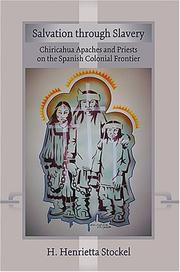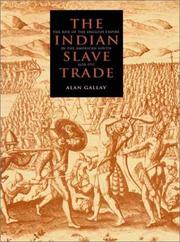| Listing 1 - 10 of 15 | << page >> |
Sort by
|
Book
ISBN: 164336362X Year: 2022 Publisher: Columbia, South Carolina : The University of South Carolina Press,
Abstract | Keywords | Export | Availability | Bookmark
 Loading...
Loading...Choose an application
- Reference Manager
- EndNote
- RefWorks (Direct export to RefWorks)
"An examination of the dual Scottish-Yamasee colonization of Port Royal. Those interested in the early colonial history of South Carolina and the southeastern borderlands will find much to discover in Carolina's Lost Colony in which historian Peter N. Moore examines the dual colonization of Port Royal at the end of the seventeenth century. From the east came Scottish Covenanters, who established the small outpost of Stuarts Town. Meanwhile, the Yamasee arrived from the south and west. These European and Indigenous colonizers made common cause as they sought to rival the English settlement of Charles Town to the north and the Spanish settlement of St. Augustine to the south. Also present were smaller Indigenous communities that had long populated the Atlantic sea islands. It is a global story whose particulars played out along a small piece of the Carolina coast. Religious idealism and commercial realities came to a head as the Scottish settlers made informal alliances with the Yamasee and helped to reinvigorate the Indian slave trade--setting in motion a series of events that transformed the region into a powder keg of colonial ambitions, unleashing a chain of hostilities, realignments, displacement, and destruction that forever altered the region"--
Enslaved Indians. --- South Carolina --- South Carolina --- History --- History
Book
ISBN: 0674056876 9780674056879 Year: 2012 Publisher: Cambridge, Massachusetts : Harvard University Press,
Abstract | Keywords | Export | Availability | Bookmark
 Loading...
Loading...Choose an application
- Reference Manager
- EndNote
- RefWorks (Direct export to RefWorks)
Indian captivities --- Enslaved Indians --- Slavery --- Indians of North America --- History.
Book
ISBN: 3110681005 Year: 2021 Publisher: Berlin, Germany : De Gruyter,
Abstract | Keywords | Export | Availability | Bookmark
 Loading...
Loading...Choose an application
- Reference Manager
- EndNote
- RefWorks (Direct export to RefWorks)
This book investigates the phenomenon of slavery and other forms of servitude experienced by people of African or indigenous origin who were taken captive and then subjected to forced labor in Charcas (Bolivia) in the 16th and 17th centuries.
Indian slaves --- Africans --- Slavery --- History --- Charcas. --- Colonialism. --- Forced labor. --- Slavery. --- Enslaved Indians
Book
ISBN: 9780544947108 9780544602670 9780547640983 Year: 2017 Publisher: Boston, Mass. Mariner Books
Abstract | Keywords | Export | Availability | Bookmark
 Loading...
Loading...Choose an application
- Reference Manager
- EndNote
- RefWorks (Direct export to RefWorks)
Since the time of Columbus, Indian slavery was illegal in much of the American continent. Yet Reséndez shows it was practiced for centuries as an open secret: there was no abolitionist movement to protect the tens of thousands of natives who were kidnapped and enslaved by the conquistadors, forced to work in the silver mines, or made to serve as domestics for Mormon settlers and rich Anglos. New evidence sheds light too on Indian enslavement of other Indians as Reséndez reveals nothing less than a key missing piece of American history
History of North America --- Enslaved Indians --- Slave trade --- Indians, Treatment of --- Indians of North America --- Slavery --- History.
Book
ISBN: 0812294106 Year: 2017 Publisher: Philadelphia, Pa. : University of Pennsylvania Press,
Abstract | Keywords | Export | Availability | Bookmark
 Loading...
Loading...Choose an application
- Reference Manager
- EndNote
- RefWorks (Direct export to RefWorks)
It is often taken as a simple truth that the Civil War and the Thirteenth Amendment to the Constitution ended slavery in the United States. In the Southwest, however, two coercive labor systems, debt peonage-in which a debtor negotiated a relationship of servitude, often lifelong, to a creditor-and Indian captivity, not only outlived the Civil War but prompted a new struggle to define freedom and bondage in the United States.In Borderlands of Slavery, William S. Kiser presents a comprehensive history of debt peonage and Indian captivity in the territory of New Mexico after the Civil War. It begins in the early 1700s with the development of Indian slavery through slave raiding and fictive kinship. By the early 1800s, debt peonage had emerged as a secondary form of coerced servitude in the Southwest, augmenting Indian slavery to meet increasing demand for labor. While indigenous captivity has received considerable scholarly attention, the widespread practice of debt peonage has been largely ignored. Kiser makes the case that these two intertwined systems were of not just regional but also national importance and must be understood within the context of antebellum slavery, the Civil War, emancipation, and Reconstruction.Kiser argues that the struggle over Indian captivity and debt peonage in the Southwest helped both to broaden the public understanding of forced servitude in post-Civil War America and to expand political and judicial philosophy regarding free labor in the reunified republic. Borderlands of Slavery emphasizes the lasting legacies of captivity and peonage in Southwestern culture and society as well as in the coercive African American labor regimes in the Jim Crow South that persevered into the early twentieth century.
Peonage --- Indian captivities --- Indian slaves --- Forced labor --- Reconstruction (U.S. history, 1865-1877) --- History --- New Mexico --- Social conditions --- Enslaved Indians

ISBN: 1283636905 0826343279 9780826343277 9780826343277 6613949361 9786613949363 9781283636902 9780826343253 0826343252 Year: 2008 Publisher: Albuquerque University of New Mexico Press
Abstract | Keywords | Export | Availability | Bookmark
 Loading...
Loading...Choose an application
- Reference Manager
- EndNote
- RefWorks (Direct export to RefWorks)
Stockel examines the brutal history of forced conversion and subjection of the Chiricahua Apaches by Spanish priests during the seventeenth and eighteenth centuries.
Chiricahua Indians --- Indians, Treatment of --- Enslaved Indians --- Christianity and culture --- Missions --- History. --- Jesuits --- Franciscans --- New Spain --- Mexico
Book
ISBN: 2894287429 Year: 2004 Volume: CQ139. Publisher: Montréal : Hurtubise HMH,
Abstract | Keywords | Export | Availability | Bookmark
 Loading...
Loading...Choose an application
- Reference Manager
- EndNote
- RefWorks (Direct export to RefWorks)
Slavery --- Slavery --- Enslaved Indians --- Enslaved persons --- Slaveholders --- Esclavage --- Esclavage --- Esclaves indiens d'Amérique --- Esclaves --- Propriétaires d'esclaves --- History. --- History. --- History. --- Biography --- Dictionaries --- French. --- Biography --- Dictionaries --- French. --- Histoire --- Histoire --- Histoire --- Biographies --- Dictionnaires français --- Biographies --- Dictionnaires français

ISBN: 1281731404 9786611731403 0300133219 9780300133219 9781281731401 0300087543 9780300087543 6611731407 Year: 2002 Publisher: New Haven : Yale University Press,
Abstract | Keywords | Export | Availability | Bookmark
 Loading...
Loading...Choose an application
- Reference Manager
- EndNote
- RefWorks (Direct export to RefWorks)
This absorbing book is the first ever to focus on the traffic in Indian slaves during the early years of the American South. The Indian slave trade was of central importance from the Carolina coast to the Mississippi Valley for nearly fifty years, linking southern lives and creating a whirlwind of violence and profit-making, argues Alan Gallay. He documents in vivid detail how the trade operated, the processes by which Europeans and Native Americans became participants, and the profound consequences for the South and its peoples. The author places Native Americans at the center of the story of European colonization and the evolution of plantation slavery in America. He explores the impact of such contemporary forces as the African slave trade, the unification of England and Scotland, and the competition among European empires as well as political and religious divisions in England and in South Carolina. Gallay also analyzes how Native American societies approached warfare, diplomacy, and decisions about allying and trading with Europeans. His wide-ranging research not only illuminates a crucial crossroad of European and Native American history but also establishes a new context for understanding racism, colonialism, and the meaning of ethnicity in early America.
Slave trade --- Indian slaves --- Indians, Treatment of --- Indians of North America --- American aborigines --- American Indians --- First Nations (North America) --- Indians of the United States --- Indigenous peoples --- Native Americans --- North American Indians --- Indians --- Slaves --- History --- Social conditions. --- Culture --- Ethnology --- Government relations --- Social conditions --- Enslaved persons --- Enslaved Indians

ISBN: 1281241466 9786611241469 0803237448 9780803237445 9780803239722 0803239726 9781281241467 6611241469 Year: 2008 Publisher: Lincoln University of Nebraska Press
Abstract | Keywords | Export | Availability | Bookmark
 Loading...
Loading...Choose an application
- Reference Manager
- EndNote
- RefWorks (Direct export to RefWorks)
The Yamasee War was a violent and bloody conflict between southeastern American Indian tribes and English colonists in South Carolina from 1715 to 1718. Ramsey's discussion of the war itself goes far beyond the coastal conflicts between Yamasees and Carolinians, however, and evaluates the regional diplomatic issues that drew Indian nations as far distant as the Choctaws in modern-day Mississippi into a far-flung anti-English alliance. In tracing the decline of Indian slavery within South Carolina during and after the war, the book reveals the shift in white racial ideology that responded to wa
Indian slaves --- Yamassee Indians --- Yamasee War, S.C., 1715-1716. --- Slaves --- Yamacraw Indians --- Creek Indians --- Indians of North America --- Yamassee War, S.C., 1715-1716 --- Yemasee War, S.C., 1715-1716 --- Yemassee War, S.C., 1715-1716 --- History. --- Commerce. --- Wars. --- Wars --- South Carolina --- History --- Yamasee Indians --- Enslaved persons --- Enslaved Indians
Book
ISBN: 1282423827 9786612423826 0803226144 9780803226142 9780803217591 0803217595 9781282423824 Year: 2009 Publisher: Lincoln University of Nebraska Press
Abstract | Keywords | Export | Availability | Bookmark
 Loading...
Loading...Choose an application
- Reference Manager
- EndNote
- RefWorks (Direct export to RefWorks)
During the two centuries following European contact, the world of late prehistoric Mississippian chiefdoms collapsed and Native communities there fragmented, migrated, coalesced, and reorganized into new and often quite different societies. The editors of this volume, Robbie Ethridge and Sheri M. Shuck-Hall, argue that such a period and region of instability and regrouping constituted a "shatter zone."
Colonists --- Europeans --- Social change --- Regionalism --- Slave trade --- Indian slaves --- Mississippian culture --- Settlers (Colonists) --- Persons --- Ethnology --- Change, Social --- Cultural change --- Cultural transformation --- Societal change --- Socio-cultural change --- Social history --- Social evolution --- Human geography --- Nationalism --- Interregionalism --- Slaves --- Temple Mound culture --- Indians of North America --- Mound-builders --- History. --- Antiquities --- North America --- Ethnic relations. --- Colonization. --- Turtle Island (Continent) --- Enslaved persons --- Enslaved Indians
| Listing 1 - 10 of 15 | << page >> |
Sort by
|

 Search
Search Feedback
Feedback About UniCat
About UniCat  Help
Help News
News